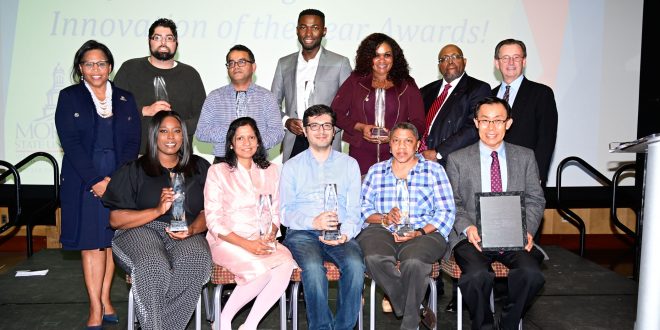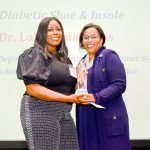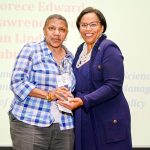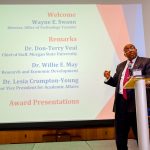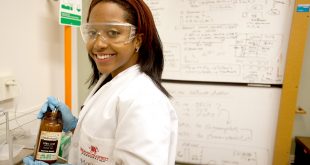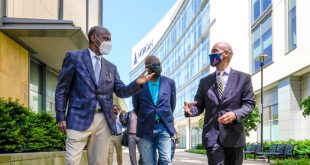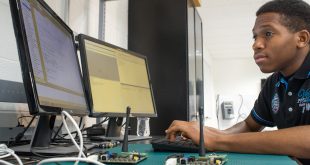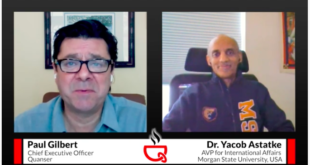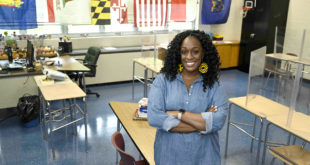Exemplifying University core values is a practice commonplace among students and faculty that’s consistently demonstrated throughout the campus. Excellence, leadership and innovation, in particular, are essential building blocks for an R2 high research classified institution. Morgan ingenuity and invention are represented by the pioneering work that is being executed in our classrooms, labs and in the field in routine fashion. Take for instance, a building occupant tracking system, a bio-product production method, a diabetic shoe and custom insole, and a perceived risk methodology, the research behind these advancements and solutions are Morgan Made, and were among those named as the top technological innovations honored at MSU’s 2nd Annual Innovation of the Year Awards.
Created by the University’s Division of Research & Economic Development’s (DRED) Office of Technology Transfer, the Innovation of the Year Awards aims to celebrate campus-wide innovation and recognize the contributions of the Morgan community and University advancement through discovery, invention and development. This year’s field of innovations represent the work from more than 60 different inventors spanning a wide range of departments throughout the university. Innovations were evaluated on their potential benefit to society, improvement over existing technology, and commercial potential. An outside review panel selected from three award finalists, generated from a pool of 67 Morgan innovations.
Lesia Crumpton-Young, Ph.D., provost and senior vice president for Academic Affairs; Willie E. May, Ph.D., vice president for Research and Economic Development; and Wayne Swann, director of the Office of Technology Transfer were on hand to congratulate inventors and present the awards.
“The recognition bestowed at the awards ceremony serves as a testament to the depth and breadth of innovation at Morgan. Our outlook is more than promising, and I look forward to solidifying Morgan as a top research university, making social and economic impacts throughout the state and Baltimore City,” said Dr. Willie E. May.
Innovation Awards are distributed in six separate categories, including Intellectual Property Innovation categories of life science, physical science, and information science. In all, 15 Innovation Awards were distributed to Morgan faculty, staff and students. Intellectual Property Awards were also given in the student, staff, and instructional innovator categories for having a positive impact on the University ecosystem. Rounding the numerous awards presented, some Morgan inventors, who had been granted patents from the U.S. Patent and Trademark Office, were also recognized for their accomplishment.
The 2nd Annual Innovation of the Year award winners included the following:
Life Science Award
Bio-Product Production Using Halotolerant Fremyella Displosiphon
Viji Sitther, Ph.D. and two of her students, Somayeh Fathabed and Behnam Tabatabai, developed a process that uses a special strain of cyanobacteria to produce biomass and can be further processed into biofuels and higher-value products in industries including pharmaceuticals, nutritional supplements, food and cosmetics.
Building Occupant Tracking
Kofi Nyarko, Ph.D. and his students, Samuel Mbugua and Christian Emiyah, developed a technology that enables building occupants or items to be tracked from room-to-room and floor-to-floor in a comprehensive, accurate, and efficient manner. The technology consists of interconnected lighting modules that form a mesh network communication system to interface with smart tags.
Diabetic Shoe & Custom Insole
LaPorchia Davis, Ph.D. developed the Davis Walker™ diabetic shoe and 3D printed customized insole to cater to individuals with prediabetes and Type 1 and Type 2 diabetes. The fashionable shoe insole is customized for individuals and while featuring several comfort features to minimize foot sores/blisters, and not deter physical activity.
Information Science Award
Perceived Risk Hierarchy Methodology
The Perceived Risk Hierarchy Methodology was developed by Lorece Edwards, Ph.D., Sabriya Dennis, Ph.D., Lawrence Brown, Ph.D. and Ian Lindong, Ph.D. The methodology determines the risks of engaging in violence, becoming addicted to opioids or other substances or contracting HIV/AIDS, among other factors, and enables more targeted intervention strategies to produce more positive outcomes.
Student Innovator of the Year
Amirreza Nickkar, a student in the School of Engineering’s doctoral program, was recognized for his contributions to a number of research projects and publications. He recently worked with Dr. Young-Jae Lee on a number of projects and recently filed a patent from their research, “Optimal Automated Demand Responsive Feeder Transit Operation Method.”
Instructional Innovator of the Year
Md Mahmudur Rahman, Ph.D. was recognized for dedication to the advancement of the Computer Science Department. Dr. Rahman infused computational thinking with a visual programming environment and interactive learning skills by using both the interactive software platform and interactive book (eBook) into the delivery of courses. His strategies resulted in doubling the retention of students in computer science majors as compared to only a few years ago.
Staff Innovator of the Year
Debbie Duran, MBA designed and managed the implementation of the Morgan Employee Management System (MEMS). In the implementation of this new system, she also trained over 300 employees, university-wide on its use. The MEMS system has improved university efficiency and effectiveness overall. The MEMS allows applicants to submit applications electronically, seamlessly, eliminating the use of paper, shortening a 6-9 months processing window.
Patent Awardees
Seong Lee, Ph.D. – U.S. Patent 10,253,974
“The Method and Design of the Ultra-Clean Mobile Combustor for Waste Biomass & Poultry Disposal”
This system consists of a swirling fluidized bed combustion (SFBC) chamber, and a second stage combustion element carried out in a cyclone separator. The system can convert chicken litter into heat or electricity, and this would benefit farmers who have to maintain certain temperature levels inside their chicken houses.
Kofi Nyarko, Ph.D., Christian Emiyah, and Samuel Mbugua – U.S. Patent 10,333,620
“Building Occupant Tracking with Visible Light Communication Sequential Relay Messaging and Lighting Modules”
This technology employs visible light communication (“VLC”) to determine indoor position location. A mobile receiver in the form of a tag or badge attached to the person or item to be tracked receives a distinctive VLC signal, and transmits a signal back to a mesh network to determine the tag’s or badge’s physical position with respect to the individual network modules.
 Morgan State University Newsroom Morgan State University
Morgan State University Newsroom Morgan State University
